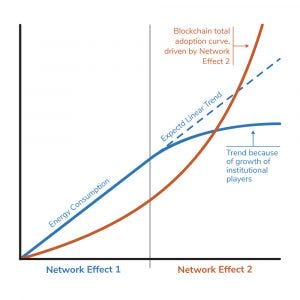By Phillip Ng, VP of Corporate Development
Satoshi created not only the world’s first cryptocurrency but a technology revolution that is changing the world. However, the average person today may argue that Bitcoin and blockchain are actually destroying the world. What’s behind this negative perception? Energy. Satoshi’s invention has spawned thousands of cryptocurrencies and blockchain projects that are placing unsustainable demands on the world’s energy resources.
The Problem
One of the many brilliant ideas developed by Satoshi uses the principle of network effects to secure Bitcoin and grow the value of the network through the process of mining. But his concept is also the reason that Bitcoin mining is so energy-intensive. As miners secure the network and process transactions in exchange for cryptocurrencies, they are incentivized to make that cryptocurrency as valuable as possible by increasing the value of the network. As the value of the network grows, more miners will join the network and the cycle repeats again. The power of this network effect in action is one of the greatest events of our time. It has taken cryptocurrencies from a novelty to a worldwide phenomenon — and it is also the driver behind tremendous energy expenditure, as more miners translate to more energy demands.
How much energy, exactly? As of June 2018, Bitcoin mining uses 27 terawatt hours (TWh) per year. If Bitcoin were a country, it would now be the world’s 41st largest energy consumer, just behind Chile. What’s more, the energy demands of Bitcoin mining are growing at an astounding rate, increasing many multiples in the last year alone. The pace has caused concern and consternation among many observers of the blockchain revolution.
As the global community confronts this growing energy demand, we’re poised to enter a new phase in the blockchain revolution, though it’s important to recognize that this revolution will not be linear. Here we’ll walk through the pros and cons of several potential energy-reduction solutions. We’ll also explore important historical lessons about predicting rates of change in the midst of a revolution and look at a noteworthy network effect that’s just starting to bloom.
Proposed Solutions
To date, experts have offered several potential solutions to help reduce the massive energy requirements from Bitcoin mining:

Possible Solution #1: More efficient miners
As the blockchain community grows, more companies are becoming involved in making the hardware that supports the computing necessary for blockchain processing. As the hardware landscape becomes increasingly competitive, new and significantly more efficient chips will come onto the market. Unfortunately, the potential for this solution to save energy is low. Cryptocurrency networks programmatically sense the level of available computing power and accommodate accordingly.
Possible Solution #2: Proof of Stake (PoS)
Many brilliant minds are working on alternatives to the current proof-of-work-based consensus algorithm. The hope is to reduce the power consumption of blockchain networks by creating more efficient methods of maintaining ledger integrity. Some of these ideas are pretty far along (Casper by Ethereum, for example) but they haven’t been released yet or achieved widespread adoption — so any potential impact from this solution still seems to be in the distant future.
The impact of PoS-based architectures may also be dampened because most implementations seem to increase the authority or “stake” of some of the nodes, which can look very similar to centralization. In addition, for PoS to have a meaningful impact, it must be adopted by all networks, further hindering its ability to quickly gain traction.
Possible Solution #3: Cheap and renewable energy usage
Placing mining close to cheap and renewable energy is another approach to the proposed problem. Consuming renewable energy to perform blockchain computation is certainly better than using dirty power, but it has no real impact on reducing the overall energy use of blockchain networks. In fact, it can have a detrimental impact because a mining operation may actually consume more green energy that would otherwise be produced and used by the green grid, ultimately forcing the grid to purchase more dirty power to accommodate for the shortfall.
Possible Solution #4: New code (e.g., Lightning Network)
Using a new code, such as the Lightning Network, could reduce transaction fees but it wouldn’t reduce the overall energy use of the network. In fact, second layer solutions consume more power since they add a layer of processing on top of the overall network itself.
For Bitcoin to implement the Lightning Network, for example, Bitcoin blocks would continue to operate at maximum capacity due to their throughput limit (every 10 minutes) and as a result, all second layer solutions must eventually submit a ‘meta-transaction’ to the original chain — creating additional processing costs.
Possible Solution #5: New blockchain applications
Blockchain applications (Dapps) will eventually have a large impact on reducing energy use. These apps will drive efficiencies in many of the characteristics mentioned above, as well as drive the development of new specialized, energy-saving networks. The development of this part of the ecosystem is still in its early stages, so it will take time before it generates significant increases in efficiency. In fact, you could argue that the fundamental efficiencies in the network need to be established first in order to foster the growth of new widespread blockchain applications. As such, it becomes a chicken-and-egg problem.
The Malthusian Trap
So what are we to make of this? None of the present potential solutions offer an immediate remedy to the demand that cryptocurrency has placed on the world’s total energy supply. Given the current trend, it would be easy to surmise that energy consumed by the blockchain will soon rival that of the rest of the normal economy.
However, to draw such a conclusion would be to commit the same error of calculation Thomas Malthus committed almost two hundred years ago.
In 1798, Thomas Malthus conducted a study of population growth rates and reached a dire prediction. Malthus compared the English population’s exponential growth rates (each family having several children) against the country’s linear food production curve, as there is only a fixed amount of arable which may be used for farming. The comparison of exponential growth in population vs linear growth in food supply became known as the Malthusian Trap. Simply put, a constantly growing number of hungry mouths strain a country’s resources, lower per capita income, and prevent any country from ever-growing rich (or even beyond subsistence for that matter).
In his calculus, Malthus extrapolated current trends and concluded that no country could grow rich. In fact, his country was in the midst of the world’s first industrial revolution. Similarly, to simply project the same current trends of the blockchain network would be to repeat Malthus’ miscalculation.
The revolution was not linear. The revolution will not be linear.
Malthus reminds us that rates of change should be understood within a real economic framework. In today’s world, we can view cryptocurrency mining as an arms race. Miners initially began generating Bitcoin using their desktops’ CPUs. Later, miners transitioned to GPU computation, on to FPGAs, and finally to ASIC-based mining. Each of these transitions represented a step-function in computing power available to miners. Likewise, miners have become large, global institutions seeking cheap power worldwide in order to achieve efficiencies of scale. As these mining institutions scale, they increased competition and the costs required to generate new coins across their respective networks. The result is lower incentives for new players to join (unless they can do so in a big way) and slowing the overall network’s growth in computing power.
Thus, we see power consumption has and will begin to level off. The growing demand and interest in bitcoin and blockchain generally have incentivized new users to join and secure the network. Now, difficulty and competition are driving network growth rates down. The trend has not been constant.

Wave Two: From one network effect to another
Satoshi’s network effect has incubated fledgling cryptocurrencies into real and powerful networks. Along with it, mining has transitioned from hobbyists to institutional players. This is an important metamorphosis and represents a new phase in the blockchain revolution.
There is a second network effect only now beginning to bloom. As large institutions grow into their future states, their incentive is to transition from seeking to grow their computing footprint (and suck down energy) to finding new and exciting ways to bring additional services onto the blockchain, further increasing the value proposition of their own existence. Glimpses of this second revolution are already being seen and represent a much more significant change in the way we work and live.
The revolution will not be linear.




